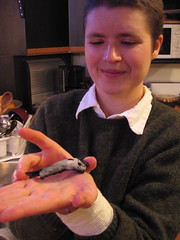The Berkman Center meets Second Life
Cory Ondrejka and John Lester from Linden Lab, the builders of Second Life, were our guests at Berkman yesterday, which turned Tuesday into “virtual worlds day”. Cory walked us through a quick slideshow, giving a sense for the remarkable growth of this unique online space, one of the key early players in a field some are calling “the immersive web”.
Cory makes it very clear that Second Life is not “a game”, but much closer to a realization of “the Metaverse” or, perhaps more closely, the “Otherverse” from the Vernor Vinge short novel “True Names”. Rather than solving quests or killing monsters as they do in massively multiplayer online games like World of Warcraft, Second Lifers build homes, businesses, complex avatars, toys and games in a shared, detailed 3-D environment. Then people chat with each other using avatars, explore each other’s buildings and creations and work together to build new parts of the world.

Near the welcome area in Second Life
The community is small, but growing rapidly. 89,000 users have signed up, and 60,000 have logged on in the past month, Cory tells us. The virtual world is now roughly 100 square kilometers, about the size of Boston and Cambridge (though much more sparsely populated.) Those 50,000 active users have generated 100 million items, 10 million of which are avatars, using the in-game 3-D object editor. The in-game economy – based on “Linden Dollars” – handles $4 million dollars (about $15,000 in real dollar terms) – per day in currency trades as players turn real currency into in-game currency, and vice versa. ($1 USD = roughly $270 Linden Dollars.) In addition, 3.5 million transactions between players – using virtual currency within the game – have taken place during the lifetime of the virtual universe.
The world requires 1600 CPUs to model – each 250m x 250m “cell” is served by a single machine. Cory didn’t get too far into technical details, but it sounds like aspects of the world – textures, text files perhaps – are served from Apache web servers, while other aspects – the wireframes and their movement – come from a custom server which talks to the client running on a user’s PC or Mac. The system backends to a MySQL database which keeps track of the properties of all objects, their place in the space, etc. Unlike many multiplayer online games, which have different servers – shards – for different groups of players, Linden Labs has two, one for adults and another for teens. On the adult server, spaces are PG or Mature, and include areas where your character can be “harmed” as well as areas where you’re immune to ill-effects.
It’s the ability for users to model and code their own objects that makes Second Life compelling, Cory believes. 25% of user time in the world is spent creating objects – because so many users are building objects at any time, there’s 7.5 “user years” put into build the world each day. Despite the challenges of writing in the Linden scripting language (the guide to the language is 129 pages of dense technical prose, starting with the user-friendly, “It follows the familiar syntax of a c/Java style language with an implicit state machine for every script…”), more than 30 million lines of code have been written in the world.
In other words, Cory believes he and his collaborators have found a way to get groups of users to solve some of the hardest problems of distributed content creation: 3D object design, programming and game development. Second Lifers have created vast castles, complex shopping malls, multi-level games as well as more serious projects, like a space that simulates the experience of schizophrenic hallucinations, or a memorial to the London bombings. Some of these creations “cross the magic circle”, building connections between the real and virtual worlds, as creators pipe video streams into Second Life or hold discussions with real-world figures like Thomas Barnett in a virtual UN.
Better yet, his creators are paying for the privlege of building the world. While membership in the community is free, owning property – which is neccesary to create buildings, or most complex structures – costs money. The smallest available plot of land – 512 square meters – costs slightly more Linden Dollars than you’re given as a newcomer to the game, requiring you to convert some real money into virtual money to buy it. Then there’s a monthly upkeep fee, which starts at $10 per month for basic land and increase as the amounts of land increase. Virtual real estate baron Anshe Chung, pays $16,000 a month in upkeep fees for the hundreds of properties she owns, reselling or renting them to other players in the game. (There’s speculation that Chung makes as much as $150,000 a year in real dollars from her Second Life activities.) Asked about the financial model for Linden Labs, Cory responded, “Land. We sell real estate.”
All of this raises an interesting question – who actually owns this stuff? Linden grants users intellectual property rights to everything that they create. That was certainly useful for Kermitt Quirk, who created a popular game, Tringo, in the game and sold it to a real-world game publisher. But it’s less clear what it means for someone who builds a beautiful and complex mansion filled with carefully scripted features written in Linden’s scripting language. At present, there’s no way to move the creation onto a non-Linden server – if you decided you didn’t want to keep paying Linden Labs for server space, you’re out of luck as your intellectual property is only useful in a Linden-owned space.
This conrasts rather sharply with the online user-created content efforts I’ve been involved with in the past. If you got sick of hosting your homepage on Tripod, it wasn’t neccesarily easy to move it to Geocities, but you could save the HTML files and JPEGs and upload them onto the new server and your page would, more or less, work. That’s because web servers and clients (browsers) use common, public standards to exchange content.
Cory explains that this is coming – “public protocols” first, where Linden Labs publishes an API that would allow people to build their own systems that are compatible with Linden’s, opening the possibility that, with sufficient time, I could write a Second Life server and invite folks to migrate from Linden’s servers to my own with their avatars and objects intact, or open a portal between our two worlds. Actually opening Linden’s codebase and allowing programmers to tinker with the server or the graphics engine on an open source basis is “farther off”. Cory explains that it requires a good deal of work for a non-open source project to clean up their code so that outside programmers can work on it, referencing the ugly, hard-to-understand code Netscape released when they decided to open-source their browser.
This raises a question of whether Linden plans on being a technology or a hosting company. If “secondlife” becomes a protocol that is supported on different clients and different servers, does Linden make its money by building the best client and server (that didn’t work so well for Netscape when Microsoft started offering a web browser for free), or by hosting the coolest, fastest online spaces (the land model.)
Until “secondlife” is a protocol and there are multiple servers providing virtual land, Anshe Chung’s gamble seems like a risky one to me. What if Linden decides to institute a “Jubilee” rule where undeveloped land is distributed to the poor? Or what if Linden simply goes out of business? The virtual assets would disappear as well, unless Second Lifers found a way to recreate the world on another server. (This has happened in the past. When the graphical chat system The Palace went out of business, Palace devotees developed servers and clients to keep the world alive on a voluteer basis.)
While Linden is surely aware that a change like repossesing land would probably generate virtual riots, they’ve sometimes made other unilateral changes that have unintended ill effects. The winner of a Second Life games contest, “Primmies”, programmed by Jeffery Gomez, discovered that his game stopped working when Linden made some tweaks in their physics engine. This points to one of the key problems of creating property in someone else’s universe – if they decide, for perfectly valid reasons, to change the laws of physics, it’s quite possible that your creations will no longer function. (Linden points out that the new code is a “preview release” and that Gomez should have tested to see if his code worked in the new environment. Again, this is a little like warning people that the laws of thermodynamics are changing and they might want to see if their internal combustion engines will still work.) Gomez has recently written a long whitepaper, speculating on what a future virtual world specification might look like, attempting to solve some of the problems he’s encountered in writing in Second Life. In a passage about Second Life, he observes:
“Second Life also has no versioning standards, as all data is controlled and maintained within the system, which is in turn maintained by Linden Lab employees. Nearly all patches to the software must happen in all areas of the world simultaneously to function properly, a holdover from MMOGs (MMO-Based Games). This often breaks existing third party software, tasking all Second Life developers with an unpredictable moving target. Furthermore, prims do not work well for soft-modelled objects, forcing users to rely on Linden Lab for objects like trees, avatar meshes, and certain aspects of ground cover. The net result is a paradox: a highly sophisticated platform that only allows less advanced applications to work effectively.”
Gomez is raising an interesting issue here – if developers don’t have sufficient control over the world, will they build anything sophisticated in it? I raised a related, but different concern – is whether Second Life is currently working because “early adopter” players are willing to become programmers… later users might not be as willing to put in such a great investment of time and creativity. Cory had an excellent response – the next generation may not be creators, but might well be remixers, taking textures, objects, animations and sounds created by the first generation of users and building their own spaces out of these premade pieces.
Put new technology in a room filled with intellectual property lawyers and interesting questions arise. As a hosting provider, Linden Labs is a DMCA safe harbor – if copyright or trademark holders complain that their work is being used without permission and Linden takes the content down, they’re protected from liability. Part of my job at Tripod had to do with managing the hundreds of notices we might get in a day that infringing material was being hosted by our webservers, copyrighted content uploaded by users to their homepages. Linden has an added challenge – they’d need to find the content, which might be somewhere speeding around a virtual world the size of a small city.
For example, let’s say that lawyers for UPS encounter this photo, a screen capture of a virtual UPS deliver truck speeding across a Second Life landscape. They can send a DMCA takedown notice to Flickr asking the image be taken down… but the source of the image is still burning virtual rubber somewhere within Second Life. What does Linden do if they get a takedown notice regarding the UPS truck? They have to find the object within the world, find the owner and alert her to the “allegations” of trademark infringement. In a world of 100 million objects, this is probably a non-trivial challenge.
Clearly Second Life is a rich enough world that it’s generating some fascinating behaviors, not all of them desirable. Cory tells us that firebombings of nightclubs have become popular – while the fire doesn’t damage anything, the computational power required to render flames slows down everyone’s framerate and makes the clubs less fun to be in. Other “griefers”, as troublemakers are referred to in the world, have built replicating objects – ultimately 5.4 billion of them – that bounce around, fill rooms and make “cells” of the world unusable as all processor cycles are occupied moving the bouncing balls around.
But other behaviors are more interesting. The best way to keep up with Second Life is a blog called New World Notes, maintained by Wagner James Au, who uses the blog to feature news from within the Second Life community. But there’s also a muckraking alternative paper, The Second Life Herald, which specializes in scandal (like an alleged in-game Ponzi scheme) and griping about server issues. Like a town with two lawyers, a town with two newspapers is always more interesting than a town with only one.
I’ve been simultaneously tempted to spend more time exploring Second Life and turned off by the sense that this world – at present – is pretty disconnected from the people and issues I’ve been working with through Geekcorps and Global Voices. I asked why Linden required a credit card to sign up for a trial account, a barrier which keeps a large number of non-US and European users from exploring the system. (The obvious answer is, “we’re in this to make money, and someone without a credit card isn’t going to become a paying user.”) Cory’s answer was that they’re using credit cards as a proxy for identity, making it possible to ban “griefers” by banning their credit cards and their IP addresses.
But he went on to point out that, since the system is only usable by people with high bandwidth connections and fast computers, the credit card wasn’t a real barrier for most Second Life users. In other words, it doesn’t matter very much that my Ghanaian friends can’t get onto Second Life because they’re going to have an awfully hard time accessing the world from Busy Internet anyway. Cory was surprised that I was able to interact in Second Life (painfully, haltingly) using my PowerBook 12″ (which is only 4 months old, but too slow to be a good Second Life client…)
Perhaps it’s stupid to be considering what it means that these new spaces are only open to people rich enough to afford high powered computers and to pay maintenance on virtual land… and lucky enough to live in countries with high-bandwidth connections to the Internet. But I got a lot of funny looks when, in 1994, I started asking whether it should be a priority for Ghana to get connected to the Internet. People in developing nations are already finding ways to make money as gold farmers, doing repetitive tasks in online games to create currency, which can be sold for real currency. I think it would be pretty exciting if unemployed kids in African cybercafes could get introduced to programming by building custom objects for wealthy Second Life users who don’t have time to create their own mansions. (You know, like me.)
Ultimately projects like Second Life interest me for the same reason blogs and wikis interest me – the beauty of the Internet is that anyone who can access the net can contribute to it, making it richer, more nuanced, more complex and diverse. But until Second Life – or an open, non-proprietary, distributed successor – becomes accessible to a wider set of users, it’s going to fall short of its potential to become a space where people from all over the world can meet and interact.
That isn’t to say that Second Life won’t overcome these barriers. I wrote a paper, “Making Room for the Third World in the Second Superpower” that talked about the problems I had with the idea that cyberspace was going to be a space for political activism and change – until that space includes Africans, Central Asians, Eastern Europeans, etc., there are certain issues and types of change that we can’t expect to see happen. But the past year of work on Global Voices has convinced me that these barriers, while very real, are surmountable, and that cyberspace can be a space where people from througout the world have conversations and arguments.
Maybe it’s time to think about writing “Making Room for the Third World in Second Life”?











